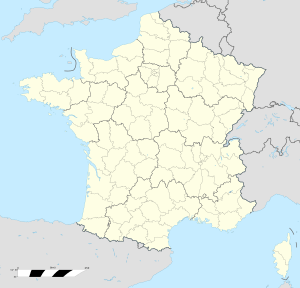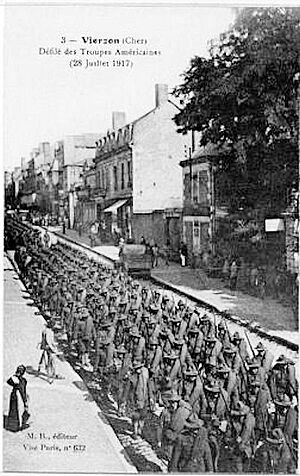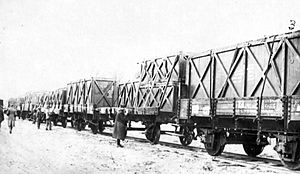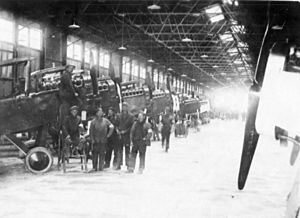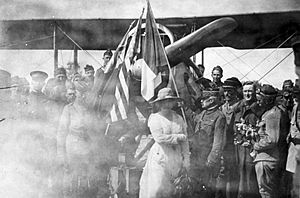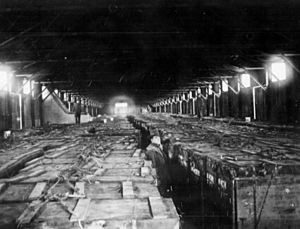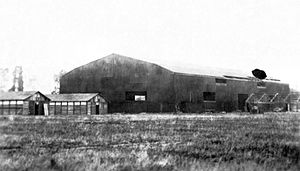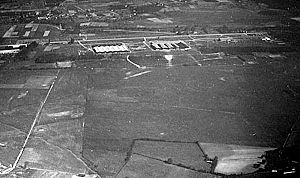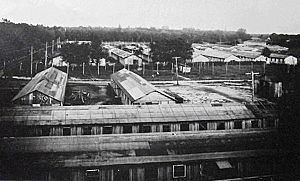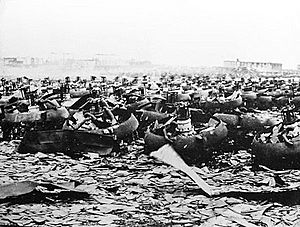Romorantin - Pruniers Air Detachment facts for kids
Quick facts for kids DA 273 Romorantin - Pruniers Air Detachment Romorantin Aerodrome Air Service Production Center No. 2. |
|
|---|---|
| Part of French Air Force Armée de l'Air |
|
| Located near: Romorantin-Lanthenay, France | |
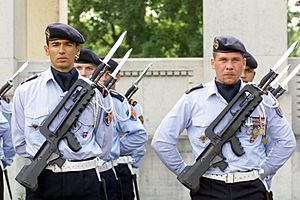
French Air Force Riflemen-commando, armed with FAMAS F1 assault rifles,
|
|
| Coordinates | 47°19′11″N 001°41′05″E / 47.31972°N 1.68472°E |
| Site information | |
| Owner | |
| Controlled by | |
| Condition | Air Force Station |
| Site history | |
| Built | 1912 |
| In use | 1913–Present |
| Battles/wars | World War I World War II |
| Garrison information | |
| Garrison |  DA 273 DA 273 |
The Romorantin - Pruniers Air Detachment (DA 273) is a military base for the French Air Force. It is located about 6 kilometers (3.7 miles) southwest of Romorantin-Lanthenay in central France.
This airfield was once a huge supply center for the United States Army Air Service during World War I. After the war, it remained active. The French Air Force built a new depot here in 1934. During World War II, the German Luftwaffe used the airfield a little, but it became a French depot again in September 1944.
Contents
What DA 273 Does Today
DA 273 is mainly a supply base. It helps repair aircraft by keeping lots of spare parts in its warehouses. It also prints and gives out technical documents for the French Air Force.
The base has a small grass airfield. This field is used for training glider pilots. It is known around the world as a great place for glider training and competitions. About 650 people work at the base. Half of them are civilians.
A Look Back: The Airfield's History
The first time airplanes were used in Romorantin was in 1911. A local professor started a group to help aviation grow. On June 3, 1911, they showed off a Blériot Aéronautique monoplane. It flew for over eight minutes! A huge crowd of more than 10,000 people watched.
In 1912, a national aviation group suggested building an airfield. A "station aéronautique" was set up near Romorantin. It opened in June 1913. This station was mostly a shelter for planes passing by.
World War I: The American Connection
During World War I, the United States joined the war. In early 1917, the Romorantin area was chosen for a large American Air Force base. This base became known as the Air Service Production Center No. 2. It was picked because the land was flat, there were lots of trees, and many railroads met there. These railroads could carry supplies to the war front.
Building the Base
On June 28, 1917, the first American soldiers arrived. They built their living quarters and a railroad line. Soon, they started building the main base. More construction units joined them.
A special area for American soldiers was set up in a nearby town. This camp eventually housed almost 30,000 people. The Americans became good friends with the local people. They visited shops and restaurants. They also hired local workers for jobs like baking and cooking.
The base grew to have over 200 buildings on 40 hectares (about 100 acres) of land. It had fuel depots, repair shops, and three landing fields. There were also large hangars for planes and balloons.
The base had a huge railroad system. It had over 200 kilometers (124 miles) of tracks! By November 1918, more than 14,000 railroad cars and 200 locomotives were at the base.
How the Base Operated
The main job of the center was to put together and test airplanes and engines made in the United States. It also became a major supply center for the DH-4 aircraft and Liberty Engines. The base also stored and repaired all the balloons used by the Air Service.
-
- Assembling and Repairing DH-4 Aircraft
Planes made in the U.S. were taken apart and put into crates. These crates were shipped across the Atlantic Ocean to France. Once they arrived, the plane parts were loaded onto trains and sent to Romorantin. This included the powerful Liberty L-12 aircraft engines.
At Romorantin, workers put the planes back together. They installed the engines, propellers, and machine guns. Sometimes, changes were made to the planes based on combat experience. After a plane was ready, pilots would test it. Then, the planes were flown to other bases closer to the war front.
The base also had a large Engineering Department. This department stored spare parts and had workshops for metal and machines. They also repaired damaged radios and cameras. They even had a special facility to repair crashed planes. If a plane was too damaged, its usable parts were saved.
-
- Supply Depots
Romorantin was also a huge supply center. It stored aviation supplies, raw materials, and equipment from the United States. These supplies were then sent to other depots, schools, and combat squadrons. The depot stored things like airplane instruments, clothing, portable hangars, and tools.
Another important part was Supply Depot No. 2. This depot handled every spare part for the Liberty Engine. Each Liberty Engine needed to be checked and repaired often. So, many engines were always being worked on or kept ready. The depot also managed thousands of machine guns and ammunition.
Trains and trucks were very important for moving supplies. Workers unloaded train cars quickly, 24 hours a day, 7 days a week. During big battles, workers often stayed at their posts for 12 to 16 hours a day. They worked hard to get shipments out fast.
-
- Balloon Department
The Balloon Department provided everything needed for observation balloons at the front lines. These balloons were used to watch enemy movements. Balloons made in France and the U.S. were prepared at Romorantin. This included parachutes for the observers. The base also had a repair shop for damaged balloons. They had sewing machines and other tools to fix balloons quickly.
-
- Transportation Department
The Transportation Department repaired and shipped all motor vehicles used by the Air Service in France. They brought vehicles from ports, kept them ready, and delivered them to units. They also brought damaged vehicles back to Romorantin for repair. A school for vehicle mechanics was also set up here.
-
- Medical Department
Three large hospitals were built at Romorantin. They treated soldiers who were hurt in combat or injured during their duties. They also provided dental care.
After the War
When World War I ended in November 1918, the base slowly closed down. Many DH-4 combat planes were sent back to Romorantin. Since they were no longer needed, they were taken apart. Their engines were stored or sold. Captured German planes were also sent here for testing.
In April 1919, the Americans handed the base over to the French government. They left behind warehouses full of supplies, equipment, and tools. The French then sold off many of the items and even entire buildings. Many local farms ended up using former American buildings.
Between the World Wars
In the 1920s, a small part of the old American base was used by the French. It became an aircraft equipment and training center. It grew a lot in the 1920s and 1930s. It became a major employer in the area, offering good salaries to its civilian workers.
World War II: Attacks and Occupation
During the Battle of France in 1940, German Luftwaffe bombers attacked the base on May 25. The base was badly damaged. Polish pilots flying for France tried to defend it. The airfield was bombed again later that night. On June 5, more bombers attacked, and the main warehouse was emptied. On June 19, the German Army took control of the airfield.
After France signed an armistice with Germany, the Luftwaffe took over the airfield. It was renamed Feldluftpark Romorantin. Some former civilian workers were hired to help rebuild the airfield and build new hangars.
German bombers used Romorantin in late 1940 to attack England. Later, other German units were based there. On April 10, 1944, American Eighth Air Force bombers attacked Romorantin. They destroyed most of the German planes and facilities. You can still see bomb craters on the airfield today. The Germans left the airfield in late August 1944. The Free French Army took control on September 2.
What Happened Next
The French Air Force has used Romorantin as a storage depot since December 15, 1944. In 1973, a glider training center was created there. Today, the depot is located where the main American DH-4 assembly buildings once stood. It now mainly supports the Dassault Rafale F1 advanced fighter jet.
The old American Flying Field #1 is still a grass field. It is used by the glider training school.


